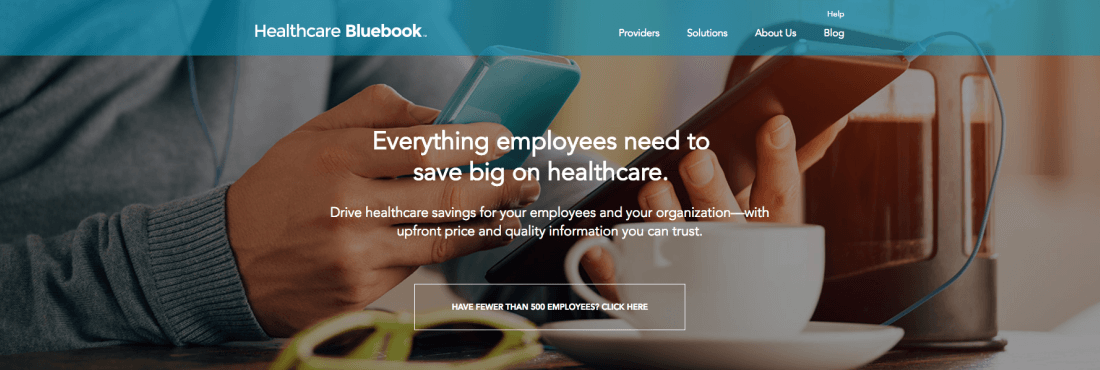
Healthcare in the U.S. is becoming increasingly expensive. According to the Centers for Medicare and Medicaid Services, healthcare spending grew nearly 6 percent in 2015, reaching $3.2 trillion or $9,990 per person. In the next year alone, health insurance premiums are increasing by 50 percent or more for many consumers. Deductibles and out-of-pocket annual maximums are also growing, leaving more patients footing the bill for the majority of their medical expenses in any given year.
Fortunately, there are tools consumers can use to help them protect their finances when faced with out-of-pocket medical expenses. One such tool is Healthcare Bluebook, a company that provides patients with the price and quality information needed to become more effective healthcare consumers.
Transparency Yields Better Choices
Founded in 2007 by Bill Kampine and Dr. Jeff Rice, the creation of Healthcare Bluebook was inspired by Rice’s personal experience with wildly varying surgery prices.
“Jeff’s son, who was about 12 years old at the time, needed a one-hour outpatient foot surgery,” Kampine, Healthcare Bluebook’s Senior VP of Client Analytics, recently told RewardExpert. Though Rice shopped around to find a high-quality surgeon, he was also concerned about the surgery’s cost.

“Jeff found a surgeon who specialized in the procedure,” Kampine continued. “Once the surgery was scheduled, he called the hospital to find out how much it was going to cost. The hospital did a little bit of research and told him the price was going to be between $15,000 and $25,000. They wouldn’t know for sure until the surgery was complete.”
As a proactive consumer with a high deductible health insurance plan, Rice decided to ask the surgeon if there was an alternate location where he could perform the procedure. He discovered the surgeon also operated at an ambulatory surgery center nearby. When Rice called the surgery center to ask about price, he was told it would be $1,500.
“This happens to consumers in the healthcare system every single day,” Kampine concluded. “Healthcare Bluebook was built so that anybody, any consumer, can make a better choice and do it just as easily as Jeff did.”
Since its launch, the cost and quality transparency that Healthcare Bluebook provides has helped millions of Americans to make informed healthcare decisions as well as reduce the burden of out-of-pocket medical expenses on their finances.
Fair Price and Price Range for Your Area
Using Healthcare Bluebook is simple. “It works just like Google or any other search engine,” Kampine said. “All you have to do is select a procedure, test, or service from a dropdown menu or use the search tool to type in what you need, like an MRI.”
Once you’ve selected the procedure you want to research, Healthcare Bluebook will present you with fair price information for your area. “We publish prices in every zip code in the U.S. and every major metropolitan area,” Kampine said. “The data comes from government databases, public sources, adjudicated commercial claims data, and provider submitted prices.”
If you were researching prices for an abdominal MRI without contrast in the Denver area, for example, you would find that the Healthcare Bluebook fair price is $697. However, prices for the same procedure performed by different providers in the area range from $455 to more than $5,000.
“We help people understand the fair price, the range of prices, and then where they can go to get cost-effective, high-quality care,” Kampine added.

Smart Healthcare Shopping Means Money in Your Pocket
When it comes to minimizing the financial impact of out-of-pocket medical expenses, Kampine said the most important thing consumers need to understand is that prices vary.
“Even if you have insurance, and even if you’re going in-network and are being conscientious about what you are doing, the price on any service could vary by 200 percent to 500 percent or even more,” he continued. “In Jeff’s son’s case, that meant a difference of thousands of dollars for a non-complex outpatient surgery.”
He also noted that many of the costs associated with procedures are related to the facilities in which they are performed. “Let’s say you need to have cataract surgery and the doctor who performs it charges $450,” he explained. “That doctor is going to charge $450 whether you have your eye operated on in the hospital or at an ambulatory surgery center. However, the building fee at the ambulatory surgery center might be $1,200 rather than the $4,000 or $5,000 charged by the hospital’s outpatient surgery department. You can use your doctor, but make sure you choose the right cost-effective building for care.”
While quality ratings and provider-specific price data are only available through the premium enterprise solution designed for employers, Kampine said individual consumers can still use the free, publicly available fair price information to ensure they aren’t overpaying for procedures, tests, and other healthcare services.
“Once you know an MRI should only cost about $700, you can ask facilities what they charge,” Kampine suggested. “If you’re a cash patient, you should ask for their cash price. Most providers offer cash-pay deals to customers for outpatient services. They are often significantly lower than even the price they give health insurers.”
This tip may apply to consumers who have health insurance as well. Kampine noted that only about 20 percent of insured patients meet their deductible in any given year. “That means that 80 percent of people most years are actually cash paying patients,” he said. “For those patients, it absolutely makes sense to understand that prices vary and shop around to get a better value. All of that money is coming out of your pocket.”
